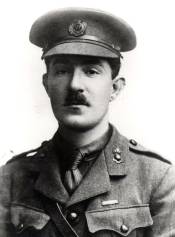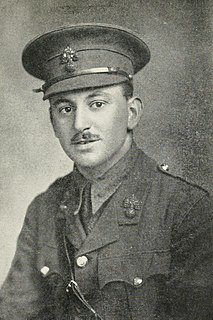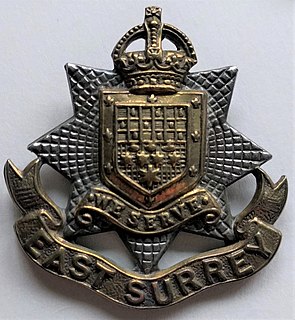
The House of Hohenzollern is a German former royal dynasty whose members were variously princes, electors, kings and emperors of Hohenzollern, Brandenburg, Prussia, the German Empire, and Romania. The family arose in the area around the town of Hechingen in Swabia during the 11th century and took their name from Hohenzollern Castle. The first ancestors of the Hohenzollerns were mentioned in 1061.

Hohenzollern-Sigmaringen was a principality in southwestern Germany. Its rulers belonged to the senior Swabian branch of the House of Hohenzollern. The Swabian Hohenzollerns were elevated to princes in 1623. The small sovereign state with the capital city of Sigmaringen was annexed to the Kingdom of Prussia in 1850 following the abdication of its sovereign in the wake of the revolutions of 1848, then became part of the newly created Province of Hohenzollern.

The Siege of Yorktown, also known as the Battle of Yorktown, the surrender at Yorktown, or the German Battle, ending on October 19, 1781, at Yorktown, Virginia, was a decisive victory by a combined force of American Continental Army troops led by General George Washington and French Army troops led by the Comte de Rochambeau over a British army commanded by British peer and Lieutenant General Charles Cornwallis. The culmination of the Yorktown campaign, the siege proved to be the last major land battle of the American Revolutionary War in the North American region, as the surrender by Cornwallis, and the capture of both him and his army, prompted the British government to negotiate an end to the conflict. The battle boosted faltering American morale and revived French enthusiasm for the war, as well as undermining popular support for the conflict in Great Britain.

The Battle of Balaclava, fought on 25 October 1854 during the Crimean War, was part of the Siege of Sevastopol (1854–55), an Allied attempt to capture the port and fortress of Sevastopol, Russia's principal naval base on the Black Sea. The engagement followed the earlier Allied victory in September at the Battle of the Alma, where the Russian General Menshikov had positioned his army in an attempt to stop the Allies progressing south towards their strategic goal. Alma was the first major encounter fought in the Crimean Peninsula since the Allied landings at Kalamita Bay on 14 September, and was a clear battlefield success; but a tardy pursuit by the Allies failed to gain a decisive victory, allowing the Russians to regroup, recover and prepare their defence.

Swabia is a cultural, historic and linguistic region in southwestern Germany. The name is ultimately derived from the medieval Duchy of Swabia, one of the German stem duchies, representing the territory of Alemannia, whose inhabitants interchangeably were called Alemanni or Suebi.

Major General The Honourable Edward James Montagu-Stuart-Wortley, was a senior British Army officer. He saw extensive active service in many parts of world, including Afghanistan, South Africa, Egypt, Turkey, Malta, Sudan, France and Ireland. He was the source of the "interview" with Kaiser Wilhelm II that was the basis of the Daily Telegraph Affair that weakened the Kaiser's political power in Germany. During the First World War he was controversially dismissed after the Battle of the Somme due to the failure of his division's diversionary attack.

Colonel James Lennox Dawson VC was a Scottish recipient of the Victoria Cross, the highest and most prestigious award for gallantry in the face of the enemy that can be awarded to British and Commonwealth forces.

Captain James Dalgleish Pollock VC was a Scottish recipient of the Victoria Cross, the highest and most prestigious award for gallantry in the face of the enemy that can be awarded to British and Commonwealth forces.

A redoubt is a fort or fort system usually consisting of an enclosed defensive emplacement outside a larger fort, usually relying on earthworks, although some are constructed of stone or brick. It is meant to protect soldiers outside the main defensive line and can be a permanent structure or a hastily constructed temporary fortification. The word means "a place of retreat". Redoubts were a component of the military strategies of most European empires during the colonial era, especially in the outer works of Vauban-style fortresses made popular during the 17th century, although the concept of redoubts has existed since medieval times. A redoubt differs from a redan in that the redan is open in the rear, whereas the redoubt was considered an enclosed work.
Hohenzollern may refer to:

The Actions of the Hohenzollern Redoubt took place from 13–19 October 1915, at the Hohenzollern Redoubt near Auchy-les-Mines in France, on the Western Front in World War I. In the aftermath of the Battle of Loos, the 9th (Scottish) Division captured the strongpoint and then lost it to a German counter-attack. The British attack on 13 October failed and resulted in 3,643 casualties, mostly in the first few minutes. In the British Official History, J. E. Edmonds wrote that "The fighting [from 13–14 October] had not improved the general situation in any way and had brought nothing but useless slaughter of infantry".

Auchy-les-Mines is a commune in the Pas-de-Calais department in the Hauts-de-France region of France. Until 1926 it was named Auchy-lez-La-Bassée.
Colonel Robert Frederick Ratcliff was an English brewer, Territorial Army officer and politician who represented Burton from 1900 to 1918.

Roland Erasmus Philipps, was a writer and a leading Scout official. He was the second son of John Philipps, 1st Viscount St Davids and his first wife, Leonora Gerstenberg. He was educated at Twyford School, Winchester College and New College, Oxford.
Harry Alexander was a rugby union international who represented England from 1900 to 1902, and was captain for one match, against Wales.

The Loss of the Kink Salient occurred during a local attack on 11 May 1916, by the 3rd Bavarian Division on the positions of the 15th (Scottish) Division. The attack took place at the west end of the Hohenzollern Redoubt near Loos, on the Western Front during the First World War. An unprecedented bombardment demolished the British front line, then specially trained German assault units rushed the survivors and captured the British front line and the second line of defence; British tunnellers were trapped in their galleries and taken prisoner.

The Hohenzollern Redoubt action, 2–18 March 1916 was fought on the Western Front during the First World War. The Hohenzollern Redoubt was a German defensive position north of Loos-en-Gohelle (Loos), a mining town north-west of Lens in France. The Redoubt was fought over by the British and German armies from the Battle of Loos to the beginning of the Battle of the Somme on 1 July 1916. Over the winter of 1915–1916, the 170th Tunnelling Company RE dug several galleries under the German lines in the area of the redoubt, which had changed hands several times since September 1915. In March 1916, the west side was held by the British and the east side was occupied by the Germans, with the front near a new German trench known as The Chord. No man's land had become a crater field and the Germans had an unobstructed view of the British positions from the Fosse 8 slag heap. The British front line was held by outposts to reduce the number of troops vulnerable to mine explosions and the strain of knowing that the ground could erupt at any moment.

The Hohenzollern Redoubt was a strongpoint of the German 6th Army on the Western Front during the First World War, at Auchy-les-Mines near Loos-en-Gohelle in the Nord-Pas-de-Calais region of France. Named after the House of Hohenzollern, the redoubt was fought for by German and British forces. Engagements took place from the Battle of Loos (25 September – 14 October 1915) to the beginning of the Battle of the Somme on 1 July 1916, including the Action of the Hohenzollern Redoubt in 1915 and the British Attack at the Hohenzollern Redoubt from 2 to 18 March 1916.

The 13th (Service) Battalion (Wandsworth), East Surrey Regiment was a British New Army infantry battalion during the First World War. Formed in 1915 as a hostilities-only battalion, it was part of the East Surrey Regiment garrisoned at Witley, England. Going to France in 1916, it saw action at the battles of the Somme, Cambrai, Arras and the Lys.
Geoffrey Dayrell Wood was an English first-class cricketer.














